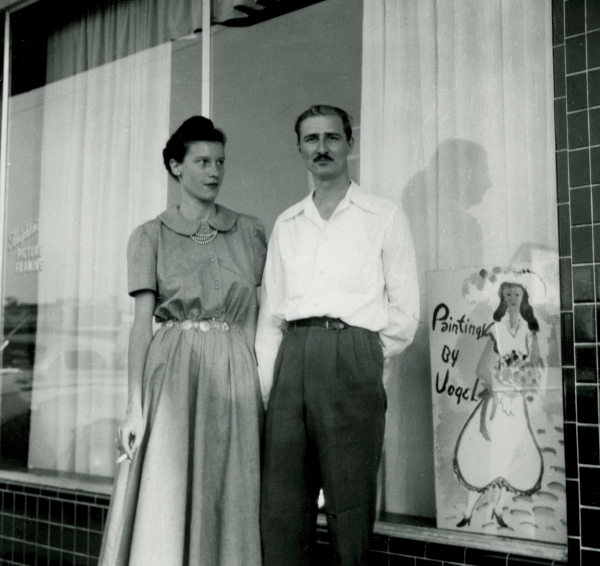 Donald & Peggy Vogel circa 1949
Donald & Peggy Vogel circa 1949
Now in its 70th year, Valley House Gallery & Sculpture Garden is
the oldest contemporary and modern art gallery in Texas. The
following history does not focus on the exceptional contemporary
artists whose efforts constitute the vast majority of the almost 500
exhibitions the gallery has presented, but instead highlights the
exhibitions that show the gallery’s interest in furthering multiple
fields of art historic scholarship.
 Donald & Peggy Vogel circa 1949
Donald & Peggy Vogel circa 1949
In many ways the creation of Valley House Gallery began on March 30, 1950, with the birth of Eric Vogel. Eric was the first child of artist Donald Vogel and his wife Margaret (Peggy). They lived in the servant quarters and garage of a burned-out house they had acquired from Dallas artist Perry Nichols on Forest Park Road, sited on approximately 5 acres of land. A friend of the Vogels and wealthy Dallas arts patron, Betty McLean, visited the Vogel home to see the new addition to their family. Betty had brought a friend with her, and Donald overheard Betty mention that she was thinking about opening a business. Donald suggested that what Dallas needed was a serious modern art gallery. Betty instantly jumped on the idea saying, “We’re in business!” and the Betty McLean Gallery was born, Valley House Gallery’s antecedent. Donald took on the role of assistant director and Peggy, Betty’s private secretary. The Betty McLean Gallery became the first commercial business to open in the new shopping center development Preston Center Village. Because of Betty’s international art world connections, the gallery immediately had access to very high quality American and European art.
 Betty McLean talking to Dallas Museum of Fine Arts Director, Jerry
Bywaters
Betty McLean talking to Dallas Museum of Fine Arts Director, Jerry
Bywaters
Exhibition No. 1 opened on April 9, 1951, and included works by American Artists George Bellows, Mary Cassatt, Charles Demuth, and Winslow Homer, and European Artists, Marc Chagall, Raoul Dufy, Henri Matisse, Claude Monet, Pablo Picasso, Camille Pissarro, Pierre-Auguste Renoir, Paul Signac, Maurice Utrillo, and Edouard Vuillard. Although not strictly adhered to, the gallery’s philosophy was to have an exhibition by an artist or artists of national or international importance followed by a show of Texas artists. They had exhibitions of internationally known artists like Toulouse-Lautrec: Lithographs; mobiles, stabiles, drawings, and Jewelry by Calder and Miro lithographs; Mark Toby and Morris Graves; Marino Marini: Sculpture, Gouaches, Drawings; Lyonel Feininger; Ben Nicholson: Paintings and Drawings; and Master Drawings from Daumier to Dali. The exhibitions of Texas artists they assembled included one-person shows of John Guerin, Bror Utter, Kelly Fearing, Dickson Reeder, Cynthia Brandts, Charles Umlauf, Clara McDonald Williamson, Seymour Fogel, and Michael Frary.
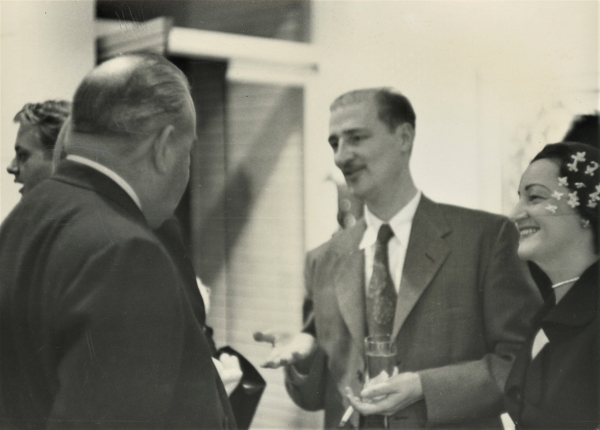 Donald greeting guests at Betty McLean Gallery premiere.
Donald greeting guests at Betty McLean Gallery premiere.
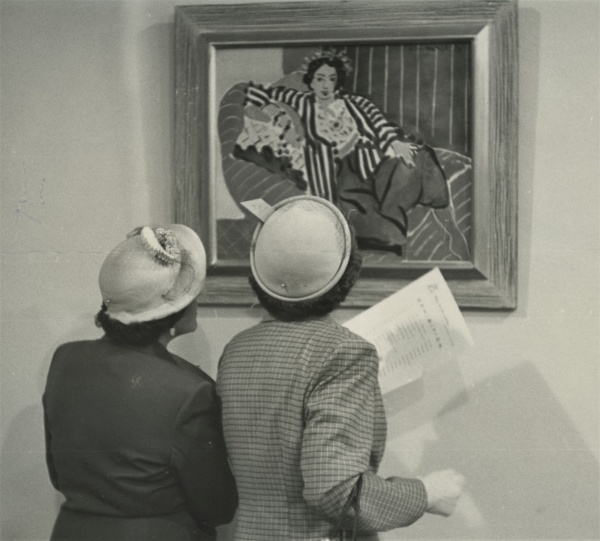 Two gallery patrons
viewing a Matisse Odalisque
Two gallery patrons
viewing a Matisse Odalisque
With the stability of both Donald and Peggy working full time, they decided to build a house on the foundation of the original residence on Forest Park Road. Donald drew up a plan for a two bedroom, two bath modernist house based around two great rooms to fit the foundation’s footprint. He designed the central room to contain the kitchen, dining, and living spaces and the second room to be his studio with large north facing windows.
While developing their long-term plans for the property, there seemed
to be a great deal of outside interest in purchasing it. Since
they had made the decision to build, they rebuffed offers as soon as
they came in. When the offers did not stop and eventually
reached the level of absurdity, Donald came up with an even more
ridiculous price, thinking that they would give up, but to his
surprise, it was immediately accepted. It turned out that their
property controlled the drainage for a new commercial development
called Exchange Park and the developers needed the property to start
building.
So, the Vogels started a search for another place to build a home and
start a framing business that would be able to service the Betty
McLean Gallery’s framing operation and provide an income stream if the
gallery closed. Their search led them north of Dallas to a
gravel covered half-mile-long dead-end stretch of Spring Valley Road,
where they stopped to investigate a white picnic table. They
entered the property and walked past the table through heavy woods and
untouched undergrowth to find that the property ended at a creek,
across which sat a manicured green golf course fairway. They
returned to the picnic table to be met by the owner of the property
who was wondering why they were trespassing. Donald asked if the
property was for sale and when presented with a price, purchased it
without negotiation. They closed on the property April Fool’s
Day, 1953.
After clearing enough of the woods and undergrowth to start building, they hired the Fort Worth modernist architect John Wesley Jones to draw up building plans for Donald’s original house design and create a new concept for a “frame factory” they intended to build simultaneously with the house. So that the studio windows would face north Donald sited the house so that its back side faced the road and the front looked out towards the back yard.
By late 1953, “Valley House” was well underway, and the frame shop was
finished and producing frames for the Betty McLean Gallery. In
September of 1954, Betty McLean, now divorced and remarried to a man
named Blake, decided to close the gallery. The gallery’s final
show closed September 14, 1954. Donald and Peggy, now without jobs and
with another baby on the way, made the decision to use the contacts
and client base they had developed and open a new gallery which they
named Valley House. While putting their plans together, they
realized that not having a gallery space for exhibitions other than
their home would be challenging, but they would try. Donald and
Peggy knew that each had skills the other did not, so Donald took on
the role of gallery director, finding artists, planning and installing
exhibitions, and sales, while Peggy acted as registrar, secretary, and
bookkeeper. Their second son, Kevin, arrived in January of 1955
delaying their first exhibition plans. To help make ends meet,
Donald taught art classes in the frame shop.
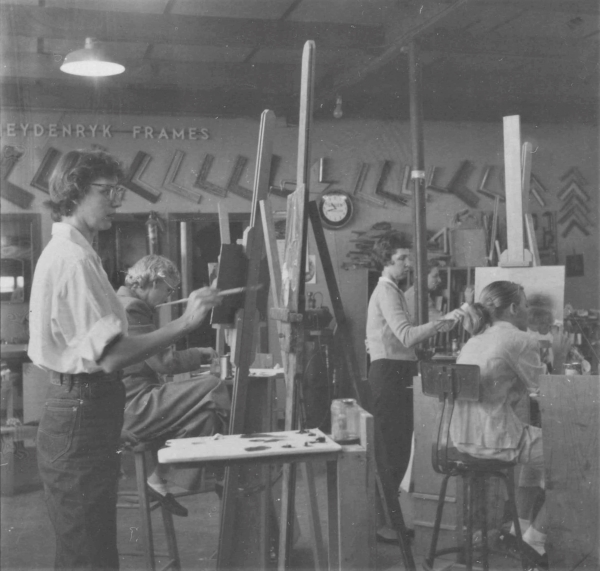 Painting
class in the Valley House Frame Shop c. 1955
Painting
class in the Valley House Frame Shop c. 1955
The first exhibition at Valley House opened April 29, of 1955 and was titled simply, Paintings and Sculpture on Exhibition. The show ran for two weeks, and it gave the Vogels a taste for sharing a two bedroom, two bath house with the public and a four-month-old baby. It quickly became evident that the house was not a good place to exhibit artwork, but it was much better than the frame shop. In March of 1957, the Vogels attempted one more exhibition in the house of paintings by Taos artist Tom Benrimo.
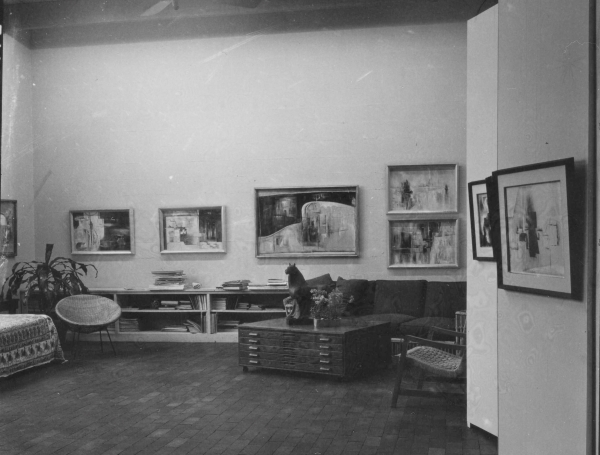
Valley House Studio, 1957 Tom Benrimo show installation
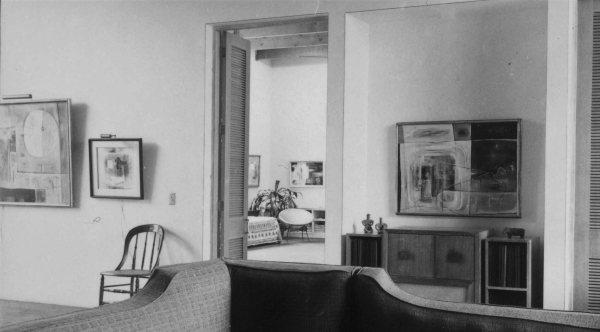 Valley House Living Room, 1957 Tom Benrimo show installation
Valley House Living Room, 1957 Tom Benrimo show installation
It became clear that the Vogels needed a dedicated exhibition space on the property. So, in June of 1957, they hired the architect Gene Bishop to design an addition to the southeast end of the frame shop that would incorporate the unused apartment space on the East end of the shop. To cover up the unsightly well pump building and water tank that was in front of the new addition, they hired the landscape design team of Marie & Arthur Berger to create a patio space around them.
They inaugurated the new gallery space in February of 1958 with an
exhibition of paintings by Paul Maxwell. Four more exhibitions
followed that year along with what Donald called, “uncrating
parties”. When the gallery received a new shipment of paintings
for a show, they would invite clients to come, have a glass of wine,
and see the new artworks as they were removed from their crates.
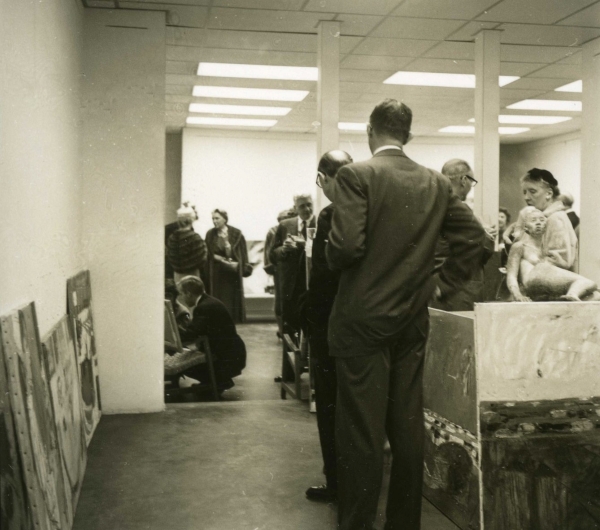 New gallery space c. 1958 during an "uncrating party"
New gallery space c. 1958 during an "uncrating party"
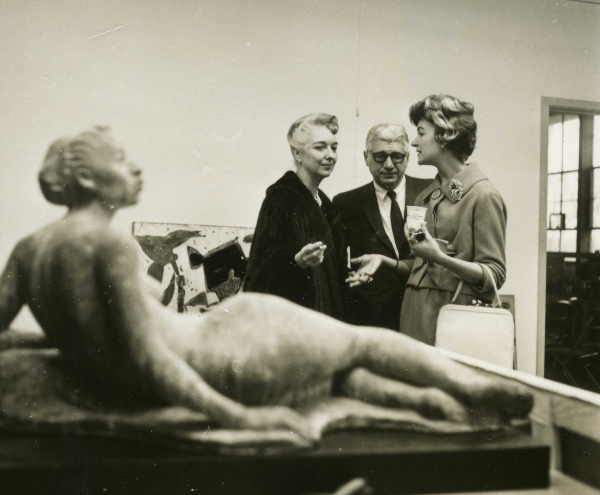 Guests
at "uncrating party", c. 1958
Guests
at "uncrating party", c. 1958
1959 saw the completion of a modernist garden plan on the Valley House property by landscape architect Clarence Roy, a designer with Lambert Landscape Company. The garden was inaugurated with a retrospective of UTAustin Sculpture Professor Charles Umlauf’s work and the exhibition was accompanied by the gallery’s first major publication.
November of 1959 heralded Valley House Gallery’s first major exhibition of paintings titled Essence of Nations. Donald had arranged to show one major work by a major artist from 5 different nations. Artists included were Mark Chagall, Rufino Tamayo, Ben Nicholson, and Japanese artist, Okumura. The most exceptional painting in the show was a Monet painting of waterlilies, a section of one of his large triptychs. Donald was unable to find a buyer in Dallas for the painting at $100,000, so it left Dallas and was immediately sold to the Cleveland Museum where it has headlined their impressionist collection ever since.
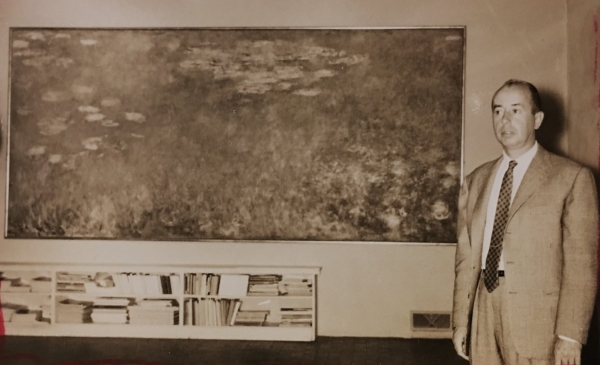 Large Monet on the back wall of Donald's Studio, Essence of Nations,
1959
Large Monet on the back wall of Donald's Studio, Essence of Nations,
1959
 Monet waterlilies installed in the Cleveland Museum of Art
Monet waterlilies installed in the Cleveland Museum of Art
Realizing Dallas was a place of great opportunity, high-end dealers in
New York approached Donald because of his association with the Betty
McLean Gallery and his work at developing relationships with these
dealers. Vogel’s ability to bring to Dallas paintings like the
waterlilies was just the beginning and through the 1960’s, Valley
House Gallery became known internationally for the quality of its
exhibitions.
In September of 1961, Wildenstein & Company, one of the world’s leading art galleries, offered Donald a show of exceptional paintings, titled A Collectors Garland: Selections from the Works of Great Masters, A loan exhibition of Master Paintings from Wildenstein & Co., Inc. New York, for the benefit of The Mentally Ill Children of Dallas. Included in the exhibition were works by Pierre Bonnard, Eugène Boudin, Paul Cézanne, Camille Corot, Gustave Courbet, Jean-Honoré Fragonard, Paul Gauguin, Vincent van Gogh, Francisco de Goya, Frans Hals, Winslow Homer, Johann Barthold Jongkind, Claude Monet, Camille Pissarro, Maurice Prendergast, Odilon Redon, Rembrandt van Rijn, Auguste Renoir, Henri Rousseau, Georges Seurat, Alfred Sisley, and Henri de Toulouse-Lautrec.
One of the most important relationships that transferred from the Betty McLean Gallery to Valley House was with Robert de Bolli. De Bolli was an attorney who represented the Ambroise Vollard Estate. Vollard was a French art dealer regarded as one of the most important dealers of French contemporary art at the turn of the century.
Donald became aware of the Pont-Aven period of the French artist
Emile Bernard when he placed a work of this period with a local
collector. Knowing that Vollard had been Bernard’s dealer, he
contacted de Bolli to see if he might have an interest in providing
Valley House with an exhibition of this little-known period of
Bernard’s painting. De Bolli agreed, and in March of 1962,
Valley House opened an exhibition of the Pont-Aven paintings of
Emile Bernard. The catalogue Donald produced for this
exhibition was the earliest publication documenting this period of
Bernard’s work.
Because of the success of the Bernard show, de Bolli granted Valley House the right to document and market one of the most significant artworks in the Vollard Estate, a work Donald considered one of the most important European artworks of the early 20th century.
As a painter himself, Vogel was very interested in the paintings and
prints of French painter George Rouault and read extensively on his
life and work. Vogel knew that Vollard had published a fine
art book which contained a poem by the French author and critic,
André Suarès titled The Passion. To illustrate Suarès’ poem,
Vollard commissioned Rouault to create a series of color intaglio
prints that were to be bound into each volume. Through his
research Donald learned that Rouault created 54 oil paintings on
paper to act as studies for the prints. After the first group
of Rouault’s intaglios were printed, Vollard determined that
creating 54 prints in Rouault’s style would make the project far too
expensive to be viable, so he convinced Rouault to allow wood
engravings to be created from his paintings to illustrate the
text. Some presentation editions of the book included
Rouault’s fabulous color prints before the project shifted
direction.
As was customary with a project like this, the artworks created by
the illustrator were normally acquired by the publisher.
Donald surmised that the original paintings for the project were
still in the Vollard Estate. After many letters to de Bolli
asking to present them, de Bolli admitted to having the works and
committed to let Valley House have the honor of introducing
Rouault’s Passion to the art world. In the 1960’s the five
most popular European modern artists were Picasso, Braque, Rouault,
Chagall, and Miro. For Donald, the ability to introduce this
unknown body of work to the art world was a dream come true.
As with several major Valley House shows, this one opened as a
benefit with great fanfare. After two years of coming close to
selling the set multiple times at what would have been a world
record price of well over one million dollars for the collection,
they were finally recalled by the estate, and Donald was told they
were ultimately sold to a Japanese collector. The current
owner is believed to be Chouzou Yoshii, creator of the Kiyoharu Art
Colony in Hokuto, the location of the Rouault Chapel.
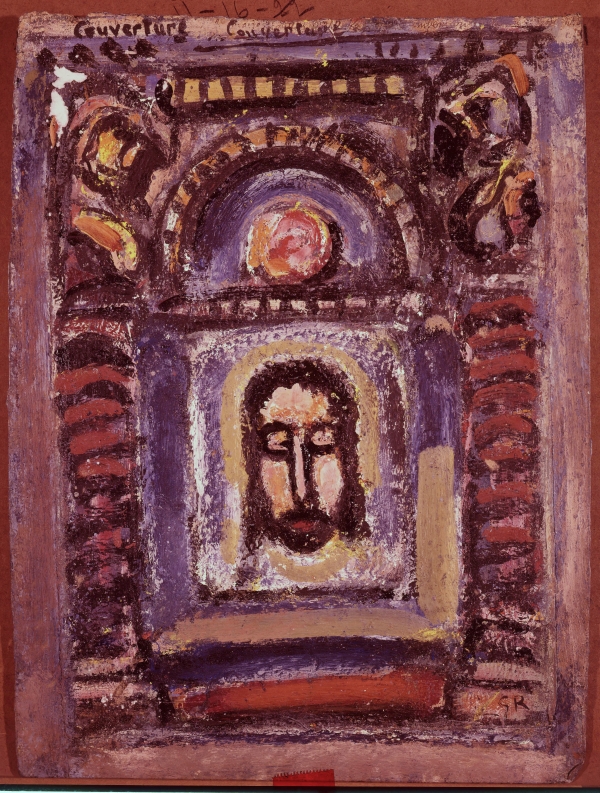
An oil on paper from Rouault's Passion
Through the end of the 1960’s, Donald continued to work with de Bolli, occasionally obtaining an impressionist painting or two from the Vollard estate. The gallery also benefitted from de Bolli’s personal representation of the school of Paris painters; Claude Venard, Jean-Marie Calmette, and François Baron-Renouard among others. In addition to granting the gallery rights to show these artists, de Bolli granted Valley House sole US representation of Claude Venard. Donald arranged shows for Venard across the country including one at the Fort Worth Art Center.
November of 1963 brought a new addition to the Vogel family, a
daughter named Katherine Barley. The Vogels knew they would have
to add a third bedroom and bath to the residence to accommodate her
and planned to add a second story for Eric and Kevin while renovating
the boys’ old room for Barley.
In 1946 Donald met Clara McDonald Williamson who, although not participating with the other artists, was attending a painting class at the Dallas Museum of Fine Art. Clara was a naive memory painter, and the teacher of the class was good enough to realize she had a gift and let her paint uninstructed. Donald recognized she was special and asked if she ever decided to sell the painting she was working on at the time, he would like first refusal. He ultimately purchased the painting and started a one-person campaign to help her sell her art. She was the first Texas artist that Donald asked to join the Betty McLean Gallery.
Although Aunt Clara had an exhibition at the Betty McLean Gallery,
it was not until March of 1964 that Donald exhibited her paintings
at Valley House. Mitchell A. Wilder, the Director of the Amon
Carter Museum of American Art in Fort Worth, saw the show and deemed
her work worthy of a traveling exhibition that opened at the museum
in 1966.
In early October of 1964, tragedy struck the Vogel household when they
discovered that the Army Core of Engineers had underestimated the
maximum flood level they assigned to White Rock Creek, which ran
behind the Valley House Property. They were off by 5’ 5” and the
residence had 54 inches of water in it and Donald lost over a hundred
of his own paintings. Friends of the gallery came through and
put together a flood sale to help the Vogels get back up and running
by late October.
The aforementioned disaster was eased when on November 20th, Valley
House Gallery was invited to join the two-year-old Art Dealers
Association of America. With this honor, they became the first
gallery in the Southern part of the US to join the then fledgling
organization.
The first major show after the flood was in April of 1965. Organized as a benefit for the Dallas Symphony, Donald put together an exhibition of over 50 works by the English sculptor Henry Moore. Works ranged from small maquettes to large outdoor sculptures, one of which was over 8 feet tall. If Donald was asked to rank what he considered the most important shows assembled during his dealing career it would be a tie between the Moore Show and the Rouault Passion.
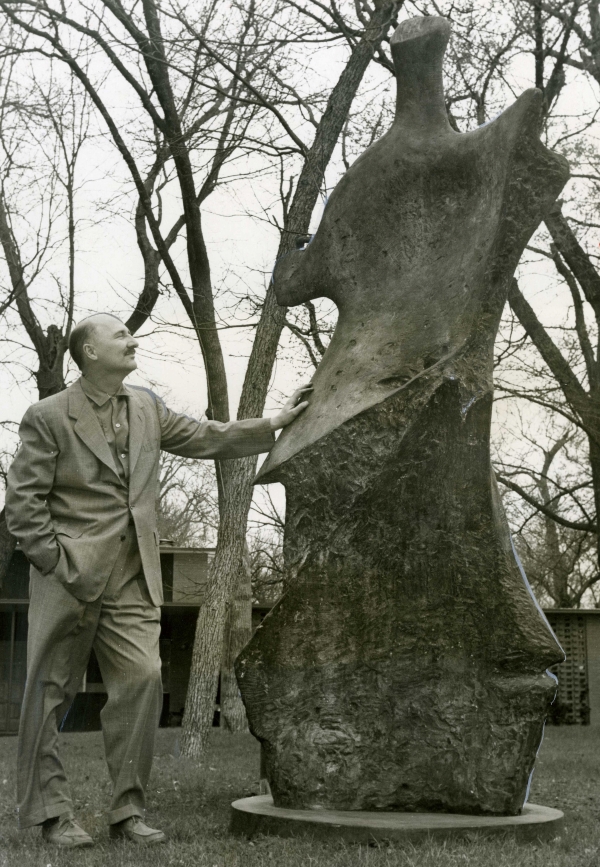 Donald Vogel with Henry Moore Knife Edge Figure, 1965
Donald Vogel with Henry Moore Knife Edge Figure, 1965
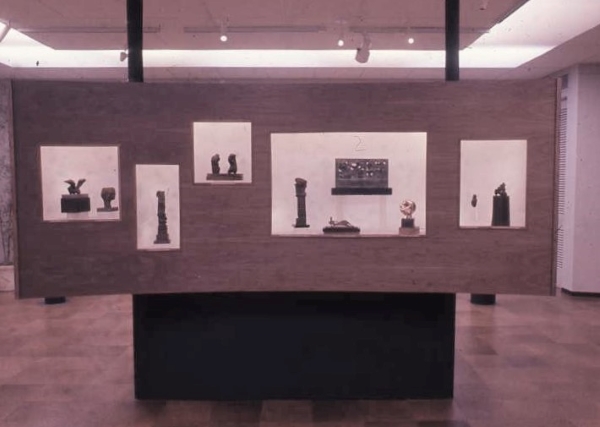 Henry Moore show works in gallery 1965
Henry Moore show works in gallery 1965
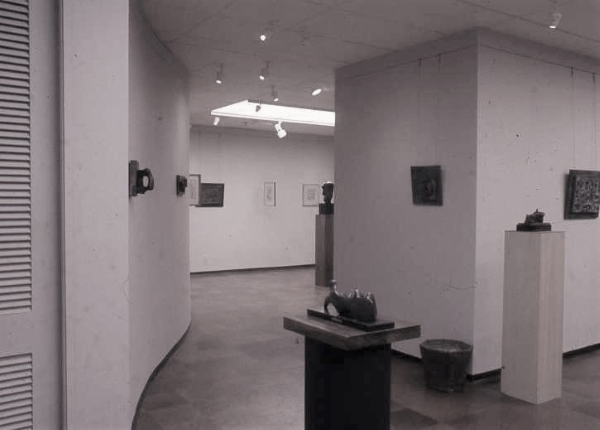 Henry Moore Show in Gallery 1965
Henry Moore Show in Gallery 1965
The Amon Carter Museum of American Art hosted a retrospective exhibition of paintings by Texas memory painter, Clara McDonald Williamson. Donald wrote the forward and Peggy wrote Aunt Clara’s biography, edited from hours of taped interviews that Donald had with her. After The Amon Carter, the exhibition traveled to the Oklahoma Art Center, The Marion Koogler McNay Art Museum in San Antonio, and ended at the Dallas Museum of Fine Arts.
In 1967 Donald Vogel, along with the Dallas developer Vincent Carrozza purchased the estate of the Pennsylvania Academy instructor Hugh Henry Breckenridge. They published a catalogue documenting the important works in the estate and then opened an exhibit in November of 1967. The catalogue became the first published biography of Breckenridge’s life and work. Breckenridge’s innovative inventory system became the model Donald used to document his own paintings.
In 1968 Donald was approached by Carrozza to partner with him on
opening a gallery in the plaza of the first of a four-building project
called Main Place that was expected to become the newest high-end
business address in downtown Dallas. Donald agreed to the idea
and began to design the space for their new venture, Main Place
Gallery. A downturn in the economy stopped the next three
buildings from happening and Donald and Peggy were faced with running
two galleries under unexpected circumstances. Carrozza, being
more of a businessman and less of a dreamer than Donald, offered to
either purchase the gallery for one dollar and shut it down or sell
his interest to the Vogels for a dollar and let them take on the
entire endeavor. The space that Donald had designed was so
beautiful, they decided to try keeping the gallery going on their
own. Shortly after the Vogels made the decision to take on
complete ownership of Main Place Gallery, Peggy was diagnosed with
breast cancer.
In late 1968, Donald was asked to represent the estate of painter Morgan Russell. Critics credited the early work of Morgan Russell and Stanton McDonald Write as the first two American painters to have influenced European art. Valley House opened an exhibition of Russell’s work in February of 1969. The collection consisted of Synchronist works, a large selection of late works inspired by mythology, and a large portfolio of drawings.
One of the most popular exhibitions Donald assembled came about when he was asked to appraise an estate of paintings. He discovered that most of the paintings were fake or falsely attributed and had been assembled by a wealthy woman’s younger husband and an art dealer to scam her out of money. Convinced he would outlive her, the deception was discovered when he died first and the family found out during the estate appraisal.
Donald had the idea to have an exhibition he called Fake, False Attribution, and True using the collection as a teaching tool. His idea was to show fake paintings next to authentic works by the same artists, and then offer those who visited the opportunity to see if they could tell which paintings were authentic, and which were not. He created a slide show about the exhibition that he presented to groups long after the exhibition had closed.
Donald, always on the look-out for exceptionally talented self-taught artists, was introduced to the Longview, Texas memory painter Velox Ward. Ward, then in his late-60’s, was actively producing wonderful paintings of his memories from growing up in Texas in the early part of the 20th Century. Donald’s first show of Ward’s opened in late September of 1970.
With the success of the Aunt Clara show, upon seeing the Velox Ward show at Valley House, Mitchell Wilder, Director of the Amon Carter, agreed to assemble a traveling retrospective to highlight Ward’s work. As before, The Amon Carter offered to generate the exhibition and asked the Vogels to interview the artist and write the catalogue essay, but this time, they asked Donald to design the catalogue too. The catalogue essay was compiled from hours of taped interviews with Ward by Donald and edited by Peggy and the gallery registrar, Rebecca Reynolds. The exhibition opened on the 11th of May 1972 at the Amon Carter Museum and then traveled to The Witte Memorial Museum in San Antonio, the Wichita Falls Museum and Art Center, Amarillo Museum of Art, The Tyler Museum of Art, The Corpus Christi Museum, and closed on July 29, 1973, at the Dallas Museum of Fine Arts.
In the Early part of 1970, a man came to the gallery asking for help. He had brought along his brother, Valton, and a group of drawings that Valton had done, to see if he had any talent. After hearing Valton’s story and reviewing his drawings, Donald, believing him to be an exceptionally gifted graphic artist, asked if he had ever considered printmaking. He was so impressed with the raw potential he saw in Valton’s work, he used his connections with SMU to set Valton up to work in their print department run by Professor Laurence Scholder.
After Valton completed over 50 separate plates, in a little over a
year and a half, Donald commissioned Rebecca Reynolds, the Valley
House registrar to write a book on Valton’s prints. After
Valton’s foray into intaglio printmaking, his interest switched to
painting. Proving equally talented with oil paints Donald became
Valton’s first patron, saying that in his opinion, “Valton is the most
creative force ever to come out of Texas”. Valton’s first show
of prints at Valley House was in 1971. Donald continued to
support Valton and his work well into the early 1990’s.
Because of Peggy’s illness and the strain of trying to run two galleries at once, the last in an exceptional string of Spring Sculpture shows in the garden, opened in April of 1971. Like with the Henry Moore show before, Donald used both the gallery and garden to exhibit the sculpture of Canadian Artist, Sorel Etrog.
Main Place Gallery struggled during this period and the Vogel’s made
the decision to close it with its last exhibition in January of
1973. Peggy’s cancer eventually metastasized to her brain and
was pronounced inoperable by the doctors. From the beginning of
January 1973 to well into 1975, Donald focused his attention on
looking after Peggy who passed away on June 7th of 1974, and grieving
the loss of his best friend and business partner.
The exhibitions the Vogel’s brought to Dallas from 1959 through 1971
have not been matched by any other commercial art gallery in
Texas. With Peggy’s death, Valley House settled into a less
frenetic exhibition period. Donald continued to work with
dealers in New York and Europe to find American and European
impressionist and post-impressionist paintings for area collectors and
museums. He also continued to find contemporary artists and
introduce them to the Dallas area while continuing to paint when he
had time. Kevin, now 19, saw that his father needed help and
decided to work in the gallery. On September 16, 1974, realizing the
financial protections it would afford after dealing with Peggy’s
estate, Donald incorporated Valley House Gallery.
During this period, Donald’s own paintings, that he sold out of his
studio rather than the gallery, became more popular and provided
additional welcome revenue to that of the gallery and frame
shop. Over the years that followed, he was represented by
Schoener Gallery in San Antonio, The Robert Rice Gallery in Houston,
the Red Piano Gallery in Hillton Head, the Ron Hall Gallery in Fort
Worth, and Newman Saunders Gallery in Wayne, Pennsylvania.
After Peggy’s death, Donald’s first major exhibition was, with the help of Helen Serger of La Boetie Gallery in New York, most likely the first Surrealist exhibition by a commercial gallery in Texas. He published a catalogue to document the show and included a work by Valton Tyler to show how his work related to the movement. Included in the exhibition were works by surrealists: Magritte, Tanguy, Dali, Delvaux, Brenner, Masson, Cornell, and Picasso.
Contrary to its title this exhibition did not mark the 25th anniversary of Valley House Gallery but what Donald most likely considered the 25th anniversary of his becoming an art dealer. There were works in this exhibition by 48 historically significant American artists, including: Bierstadt, Blakelock, Blume, Burchfield, Cassatt, Church, Cope, Demuth, Glackens, Hartley, Hassam, Heade, Homer, Hopper, Inness, Johnson, Kuhn, Lawson, Marin, Parrish, and Peto.
In 1976, Kevin, and the Valley House picture framer John Morrie, drove a truck load of paintings and prints by Valton Tyler to exhibit his work in the first American art fair titled The Washington International Art Fair or "Wash Art". The exposure of Valton’s work at this fair led to a solo exhibition of Valton’s work at Galerie Claude Jongen in Brussels, Belgium, a gallery that specialized in Surrealism and represented the estate of de Chirico. Today, Valley House continues to promote their contemporary artists through art fairs.
Cheryl Westgard, an SMU student took a temporary summer job as
registrar at Valley House before starting graduate school on May 19th,
1978. At the end of that summer, she was offered a permanent
position and continued her graduate studies.
Donald, wanting to let people know that they could always call on him if they wanted to acquire an important work, put together another major group exhibition of American and European paintings he called To Heighten the Spirits. The exhibition opened on September 17, 1978, and included the artists Monet, Renoir, Braque, Cassatt, Gauguin, Delauney, Harnett, and Homer.
By the late 70’s, Donald had started to rely on Kevin to help generate exhibitions outside of the shows of contemporary artists the gallery represented. Because Kevin seemed to be most interested in drawings and prints, when he talked about doing a show of Whistler prints, Donald said, “then get on a plane to New York and put one together”. Kevin did, and his first curated exhibition opened on May 11, 1979.
Judging from the appraisals Donald and Kevin were seeing that
accompanied artworks people were bringing in to consign to the
gallery, it became clear that there needed to be a local appraisal
service that would provide more accurate artwork evaluations.
Although the gallery occasionally provided appraisals when asked,
Kevin and Cheryl decided to expand these services. They started
by enhancing the gallery library with reference books, and added
auction price compendiums to ones they already had, before accepting
requests for fine art insurance and estate appraisals.
In 1980, Donald Married Erika Farkac. Erika was a landscape
architect who had been running the design department at Lambert
Landscape company for many years. Erika immediately went to work
updating the Valley House Garden. Under her expert eye, the
garden took on a fresh, updated look. With a new life ahead, she
officially retired from Lamberts and started her own private landscape
design practice out of the Valley House residence.
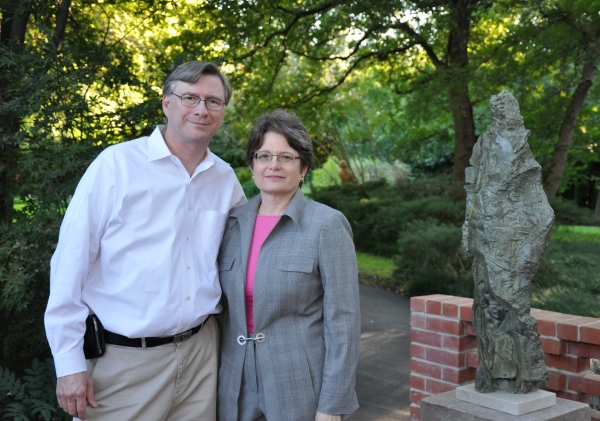 Kevin and Cheryl in the Valley House Garden, c.2010
Kevin and Cheryl in the Valley House Garden, c.2010
In July 1982 Kevin and Cheryl were married. Cheryl started working primarily with the contemporary artists represented by the gallery, arranged exhibitions of their work, and scouted for new talent. Kevin focused on curating drawing and print shows by historically significant artists and installed all the exhibitions at the gallery. Together, they took on roles mirroring Donald and Peggy when the gallery was founded.
Based on the 1961 show with Wildenstein, Collectors Garland, Donald worked with several major New York City Galleries to put together an exhibition of works by major American and European artists which he called Collectors Garland II. In his final selection were works by Boudin, Caillebotte, Chagall, Chase, Courbet, Degas, Denis, Fantin-Latour, Frieseke, Hassam, Homer, Monet, Morisot, Sargent, and Utrillo.
Three successive exhibitions reflected Kevin’s growing passion for
drawings and prints.
In November of 1984, Kevin opened shows titled Thomas Hart Benton: Early Abstract Paintings and Drawings, and Walt Kuhn: Western Watercolors. Both shows covered little known periods of these two well-known American artists’ oeuvres.
Then in February of 1985, he curated an exhibition of lithographs and sculpture by the French 19th century artist Honoré Daumier. The sculptures in the show were from a series of bronzes taken from Daumier’s painted clay characters of colorful members of the French parliament. This exhibition was followed by a retrospective of the wildlife prints of Iconic Texas Printmaker, Janet Turner.
In March of 1988, Kevin continued pursuing his love of fine prints with an exhibition of hand-colored engravings by the English Naturalist John James Audubon from his magnum opus, Birds of America.
In 1985, the Dallas Museum of Art generated an exhibition curated by
Rick Stewart titled, Lone Star Regionalism, The Dallas Nine and Their
Circle. Before this exhibition, there had been little interest
in this important period of Texas art, or early Texas Art in general,
and Kevin became fascinated with this under-appreciated area of the
market. Kevin started to search for works by the forerunners of
this movement and Valley House quickly became known as one of the main
sources for Early Texas Art. Many of the first collectors in
this field focused on prints by these artists as they were
inexpensive, and a collection could be assembled quickly. As
time went on, because of market forces, these collectors realized that
paintings by Early Texas artists could be had for not much more than
their prints, and many started to purchase paintings instead.
The first major event Kevin put together related to early Texas art
was an auction of the works by two of Texas’ most famous
mid-nineteenth century artists, Hermann Lungkwitz and Frederich
Richard Petri from the Estate of Mazie Mayes Bickler on October
29,1988. They were German immigrants, trained in the traditional
academic style of romantic painting. While Lungkwitz focused on
painting the Texas landscape, Petri loved portraiture and recorded
historic events and people, and most importantly, made portraits of
the native Texas Indians. Collectors and museum curators from
around Texas attended and most of the major works found homes.
In the mid-80’s Kevin and Cheryl met Carolyn Bullard, a print dealer who worked for an antiquarian gallery called Zeitlin & Ver Brugge, in Los Angeles. Carolyn introduced the Vogels to the book dealer Bruce Ferrini, who specialized in medieval illuminated manuscripts. Together they provided the material for the gallery’s 1988 Christmas exhibition titled: Illuminated Manuscript Leaves, 1000 AD to 1500 AD and Old Master Prints.
Being the most plastic of the print mediums, Kevin became fascinated with intaglio prints. Taking his father at his word that if you have an idea for an exhibition, “Don’t just talk about it, do it”, Kevin, working with Fred McElroy, a friend who helped as a preparator in the gallery, decided to create a comprehensive traveling educational museum exhibition on the intaglio print. Kevin would curate the exhibition to show how a collector should approach an intaglio print related to market, quality of impression, and condition; and Fred, who had a masters in printmaking, would write the catalogue to describe the differences between each intaglio process used and how they visually differ, and to create detailed appendices of printmaking terms. They both spent over a year researching, writing, and gathering materials to create displays that would demonstrate each aspect they focused on. The show opened at Valley House before traveling to several regional museums whose collections had a focus on Fine Prints.
Following a show at the Metropolitan Museum of Art on American Art Posters of the 1890s, Hirschl & Adler Gallery’s print department in New York City created a similar exhibition. Kevin saw this show and was able to bring it to Valley House in March of 1990. These posters were one of the few unique art forms coming out of America. They were published to advertise book publishers, popular magazines, and individual books. They became very collectable and sources of amusement to the newly formed middle class.
During the 1990’s Donald shifted his interest from painting to writing
and the day-to-day operation of the Gallery was left to Cheryl and
Kevin. While Cheryl worked to bring new contemporary artists
into the gallery, Kevin focused his attention on exhibitions of early
Texas artists. For the next six years, among exhibitions of the
gallery’s contemporary talent, Kevin curated the following
exhibitions:
October 15 - November 30, 1991, Otis Dozier: Drawings and Prints, 1925-1957, and Late Sculpture
April 20 - May 30, 1992, Kelly Fearing: The Influence of The Fort Worth School: Works from 1939-1955
September 11 - October 17, 1992, William Lester: Paintings of the 40's and 50's and Edward G. Eisenlohr: Drawings and Lithographs
May 14 - July 2, 1994, Texas Printmaking: From the Early 30's to 1960 and William Lester’s Stuck Studio Drawer
February 9 - March 9, 1996, Kelly Fearing: New Prints and Bertha Landers: Early Prints & Drawings, A Tribute to the Founder of the Printmakers Guild
August 23 - September 28, 1996, Texas Art of the 50s and 60s
In 1999, The Vogel Family received a D-Art Legend Award along with Melissa Miller, one of Texas’ leading contemporary artists, and Elizabeth Boeckman, a philanthropic Dallas collector. The early Texas sculptor Dorothy Austin, whose work was rarely found on the market, had read some of the press regarding the award and visited the gallery to inquire if Valley House would like to exhibit her early work. This led to an exhibition of her sculpture paired with the abstract landscape watercolors of Constance Forsyth the founder of the printmaking department at the University of Texas, Austin.
Valley House opened the new millenium as the last stop of a traveling retrospective of Donald’s paintings. Works in the show ranged from 1936 to 1998. While Donald rarely showed his work in the gallery while he was running it, Kevin and Cheryl had no issue with doing so. This exhibition would turn out to be the last of Donald’s work in the gallery while he was alive. Before ending at Valley House, the exhibition opened at The Art Center of Waco in July of 1998, and then traveled to the Tyler Museum of Art on April 3, 1999, The Amarillo Art Museum on June 5, and the Old Jail Museum in Albany, Texas on August 7.
In 2002 the son of sculptor Heri Bartscht asked if Valley House would like to represent his father’s estate. Heri had been the sculpture professor at the University of Dallas for 29 years and had helped in the creation of the Dallas Contemporary Museum, an institution that eventually merged with the Dallas Museum of Fine Art. Valley House opened a retrospective exhibition of Bartscht’s sculpture on June 7, 2002.
Kevin often said that Everett Franklin Spruce was arguably the most important modernist artist of Texas. His argument was based on the artist’s consistency in producing exceptional work throughout his career, unlike his contemporaries whose work varied in quality. When the opportunity to have a large Spruce show presented itself, he quickly accepted. The show ran from May 30 to July 3, 2003.
On February 17, 2004, while Kevin and Cheryl were setting up for the
Art Dealers Association of America’s The Art Show fair in New York
City, Donald Vogel died of heart failure.
In February of 2003, Valley House was exhibiting in New York City at the Works on Paper fair. While Kevin was passing the Thomas French Fine Art Booth, Tom called Kevin over and asked him if he knew the artist Louis Oscar Griffith. Kevin was vaguely familiar with the artist but when Tom told him that he traveled with Frank Reaugh, a Texas artistic legend, and had done color intaglio prints of Texas in the early 1900s. Kevin was very interested as color prints before that time were often lithographs that had been hand colored. Tom was working with the Griffith Estate and offered Valley House the right to show Griffith’s Texas work. This led to two exhibitions and catalogues documenting Griffith’s Texas. The first was in October of 2004 and consisted of the prints Griffith created of Texas, and related drawings. Griffith not only did the first color prints of Texas, but also did the first suite of prints to document the development of a Texas city, Dallas. The Tyler Museum of Art, collaborating with Valley House, opened an exhibition of Griffith’s Paintings of Texas in September of 2010 and Valley House followed in January of 2011.
Kevin was introduced to the pastels of Josephine Oliver while on an appraisal. Josephine had been Frank Reaugh’s muse and second in command when he took his students out into West Texas in a converted car, he called the Cicada. Kevin knew Joe Oliver, Josephine’s little brother, and often asked him if he had any of Josephine’s pastels. Joe would say he had just a few, until one day he called Kevin and told him that he had found well over 100 pastels, wrapped in magazines, out in the garage. To document the pastels that remained in the estate, Kevin published a catalogue with an essay by Dr. Rebecca Lawton, the curator of paintings and sculpture at the Amon Carter Museum and exhibited her work in May/June of 2007.
Jack Barnett, the husband of one of the gallery’s contemporary artists Vera Barnett, introduced Cheryl to the work of Sedrick Huckaby. Impressed by his show at the African American Museum in Dallas, Cheryl invited him to the gallery in hopes he would join Valley House. He eventually decided to, and after the success of his first show, had two wonderful show ideas he discussed with Cheryl. One of which was to document the last years of Big Momma, his aging grandmother. Cheryl documented the show Big Momma’s House with a catalogue, and if asked, she would say that it was one of the most important shows she curated at Valley House.
By 2010, because there were now so many dealers involved in the early
Texas market, Kevin did not feel the need to devote as much attention
to promoting the genre. Also, with the ease of flying to New
York, London, or Paris for collectors to acquire works by major 19th
and early 20th century artists, the gallery did not see the need to
continue to bring exhibitions of these works to Dallas.
From then on to the present, Kevin, Cheryl, and the gallery director, Laura Green, have focused on promoting the gallery’s contemporary artists through one-person, group, and themed exhibitions. Rather than take the contemporary artists they represented to art fairs around the country like they had been doing for years, they decided to focus their attention on their home state and promote nationally and internationally with online marketplaces such as 1stdibs.com and artsy.net, and to produce catalogues on many of the artists they represent. The only art fair at which they annually exhibit is The Dallas Art Fair, where they have exhibited since its inception.
Since the gallery’s first show in 1955 through January 1 of this year, the gallery has presented over 492 exhibitions. It has also edited, designed, and published over 70 catalogues for those shows and other institutional projects. In addition, the gallery curated, or helped curate 124 exhibitions in which the gallery either loaned work, co-curated, or generated entire exhibitions for art spaces, art centers, and museums. The gallery has participated in over 90 art fairs including the first international art fair in the U.S.
Musing about the gallery in the wake of its 70th anniversary Kevin
said:
Because of its unusual location, Valley House has always been a destination gallery. People who discover the gallery for the first time often think it is a foundation museum or a park, not a commercial business and no one in Dallas expects to find a gallery in a residential neighborhood. Currently, most discover the gallery through word of mouth or the internet. The combination of the gallery’s longevity, its sculpture garden, and its history of groundbreaking exhibitions make it unique, not only in Texas, but the region. It is not unusual for us to be helping the second, and sometimes third, generation of those clients we have worked with for decades. It is Cheryl’s and my goal to see that the Valley House Gallery and Sculpture Garden legacy lives on beyond the Vogel family’s involvement.